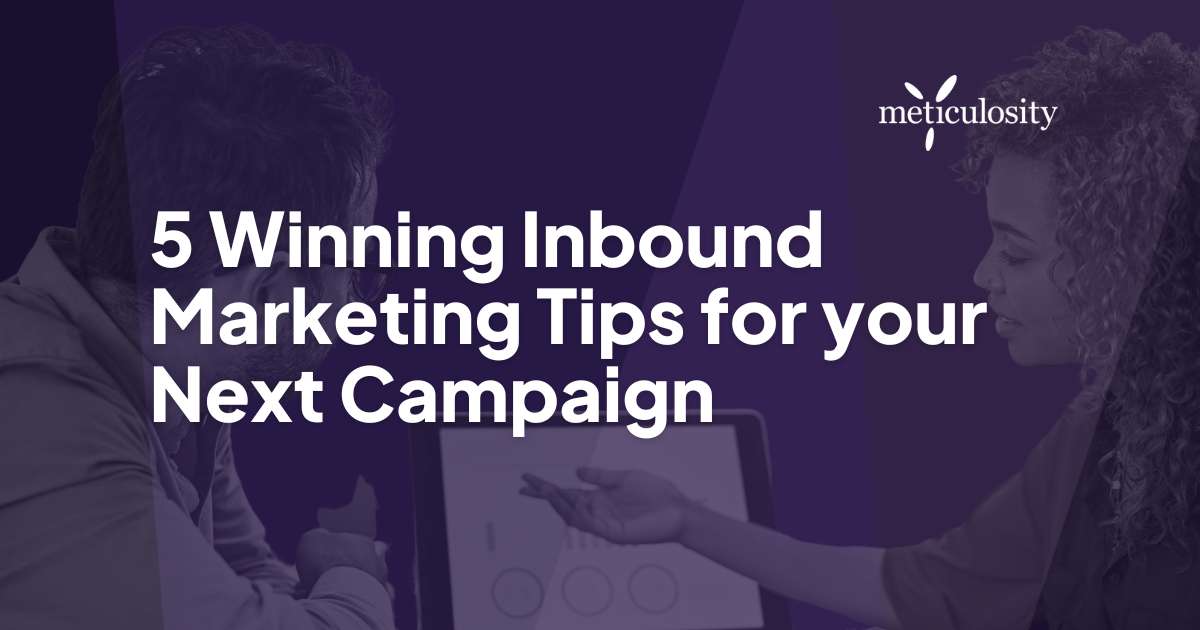An effective inbound marketing plan can have an enormous impact on your business.
Inbound marketing agencies blend SEO, social media, content marketing, and more to increase brand awareness and foster new leads.
Tips to Kickstart your Inbound Marketing
Whether you’re new to the concept or wish to refine an existing strategy, these five inbound marketing examples and useful tips can help you get started.
1. Create a Clear, Realistic Goal
While inbound campaigns are often very different from outbound campaigns, they have one element in common – a clear, focused goal that accomplishes the company’s objectives. When determining this goal, choose something that is achievable but still challenging.
/Imported_Blog_Media/Inbound-3-750x750-1.jpg?width=750&height=750&name=Inbound-3-750x750-1.jpg)
One way to determine whether an objective is realistic or not is to analyze past results. Several inbound marketing tools are available online that can help you check the effectiveness of your content. Once you determine areas where you can improve, your objectives will become more clear.
Create a Better Inbound Marketing Strategy
2. Find a Way to Measure Your Company’s Progress
Inbound strategies rely on data, so it’s important to have a method of tracking the results of your inbound strategies. Analytics inbound marketing tools allow you to categorize leads by persona type or where they are in the sales funnel. You can also analyze the effectiveness of individual blog posts or other online content.
Customer relationship management tools, or CRMs, can also help you analyze data from customers. Website analytics tools, such as Google Analytics, are widely available online. With comprehensive data regarding the performance of your campaigns, you can further customize your inbound strategy.
3. Generate Relevant Content that Meets Your Customers’ Needs
What often differentiates an inbound campaign from an outbound campaign is the type of content offered to customers.
Outbound campaigns typically utilize print or TV ads, hoping that a person viewing the advertisement needs or wants the product at that moment. Conversely, inbound campaigns feature content that is accessible to customers as long as it’s on your company’s website.
Because of the long-term nature of the content, inbound marketing agencies should focus on creating useful, informative posts. The content should be relative to issues in your industry and provide the customer with something of value. Optimize each post for specific buyer personas and for different stages of the buyer's journey. For example, posts that relay product-specific information are ideal for communicating with leads who have reached the decision stage.
4. Develop a Matching Call-to-Action
When creating an inbound campaign, many novice marketers find themselves with a great blog post or email message, but forget to ask the reader to do something else.
A well-crafted call to action is one of the most important marketing tools because it leads the customer down the sales funnel, giving them a “next step” to complete. If you haven’t developed relevant CTAs for your website pages, it’s time to start.
/Imported_Blog_Media/Inbound-2-750x500-4.jpg?width=750&height=500&name=Inbound-2-750x500-4.jpg)
You can customize CTAs to suit your company’s needs. You can also use a CTA button to direct a customer to a specific landing page, which might contain a contact form where he or she can enter a phone number. For customers further along in the sales journey, the CTA can be used to encourage them to sign up for services or complete checkout.
To be effective, a CTA must be relevant to the target persona reading the content. It should create a logical progression for where the visitor is on the buying journey and reveal what he or she will receive by clicking on the button.
5. Analyze the Gaps in Your Current Marketing Plan
Successful inbound marketing campaigns address the needs of potential customers no matter where they are in the sales journey.
Content should cater to the needs of customers just becoming aware of your product, those who are still considering its benefits, and, finally, visitors who are deciding to make a purchase.
Conclusion
If you’re missing content for any of these stages, make it a priority to develop at least one post for each stage. Closing in these content gaps can prevent customers from leaving the sales funnel, allowing them to complete their journey.
These five inbound marketing examples are just the tip of the iceberg when it comes to developing an effective plan. You’ll also want to consider site design and maximizing your reach on the internet. By implementing these strategies, you’ll have a great foundation for an inbound marketing campaign.


/Imported_Blog_Media/inbound-marketing-tips-1.jpg)




